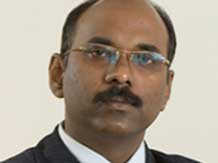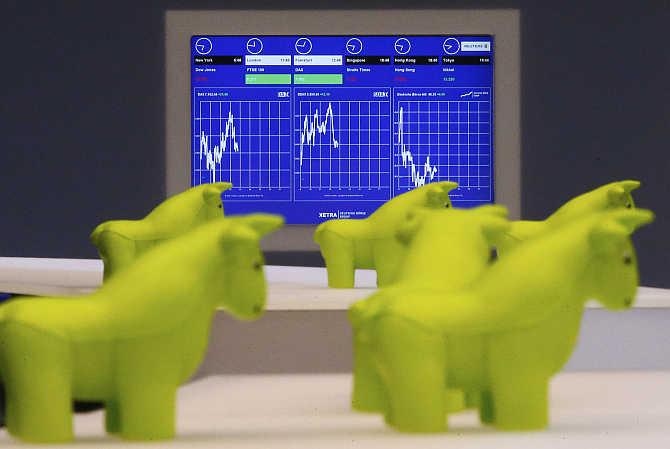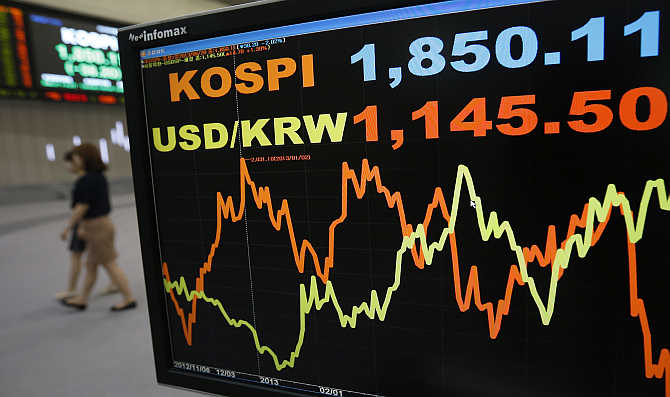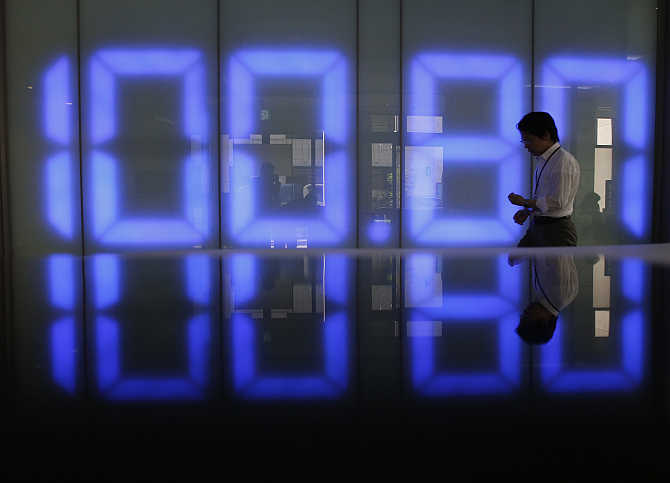 | « Back to article | Print this article |
The fall guy or a bright spot that turned black?
Is Anjani Sinha of National Spot Exchange being made the fall guy?
Anjani Sinha, below, left, is a voracious reader. He reads while he travels. He likes to read about stock market crashes, investment finance and even Agatha Christie. But his all time favourites were the works of Balzac and Somerset Maugham, he had told a Businessworld interview in 2010.
At the time, he was reading The Crash of 2008 and What it Means by George Soros. Little might he have thought then that he would be at the epicentre of a Lehman Brothers-like crisis, only three years later. Or, the smart man he was - a gold medallist in college and a veteran of screen-based trading and risk management - did he probably see it coming?
Earlier this week, Sinha, managing director and chief executive of National Spot Exchange, which is fighting an unprecedented Rs 5,600-crore (Rs 56 billion) payment crisis, took full responsibility of the situation.
 “I and my management team at the National Spot Exchange Ltd have been solely and directly responsible for all operations, including screening of parties, warehouse management, risk management and other related company matters.”
“I and my management team at the National Spot Exchange Ltd have been solely and directly responsible for all operations, including screening of parties, warehouse management, risk management and other related company matters.”
His statement came after a fortnight of firefighting by Sinha as various allegations piled up against the exchange and pressure was building up against the promoter.
Click NEXT to read more...
The fall guy or a bright spot that turned black?
Did Sinha and his “management team”, without any knowledge or assistance of the promoter, build this massive edifice, which is now crumbling? Or is he being made the fall guy? Sinha was a confident man, said people who have met him. He also surely knew his stuff well. He had great skills to adapt to the dynamic financial markets, and above all, he knew when to jump off a sinking ship, a career spanning two decades and six exchanges - three now defunct - shows.
A chartered accountant by profession, Sinha’s initiation into the commodities space came in January 2000, when he joined as the chief executive officer of the Vashi, Navi Mumbai-based Bombay Oilseeds and Oils Exchange.
“He has versatile experience in screen-based trading as well as risk management system,” a short profile of Sinha in the 73rd annual report of the exchange for the year 1999-2000 said.
At the bourse, which is now Bombay Commodoties Exchange, he spearheaded the launch of futures trading in multiple commodities under the web-enabled screen-based trading system. This is where he probably came in touch with Jignesh Shah, who was then running a fledgling technology business.
Click NEXT to read more...
The fall guy or a bright spot that turned black?
Another man, who would be a key cog along with Sinha in the electronic trading/ exchanges juggernaut of Shah over the next decade, joined the BCE as an honorary adviser in the same year. His name was Madhoo Pavaskar. Pavaskar was invited by the Financial Technologies group as a consultant to assist it in the formation of Multi Commodity Exchange.
After the founding of the MCX, Pavaskar was also on the board, briefly before resigning to take on academic pursuits. Sinha, who already had a working relationship with Pavaskar, joined MCX in 2003, while Shah was the managing director. He would go on to become the chief executive before moving on to set up NSEL.
Much has been written about the rise and rise of MCX as the premier commodities bourse. After chartered accountancy, Sinha had entered the world of exchanges when he joined as chief general manager, Magadh Stock Exchange Association, Patna, in 1990. He quickly rose to become the chief executive.
In the mid-1990s, some 15 regional stock exchanges, including Magadh, which were threatened by the entry of National Stock Exchange and nationwide screen-based trading by BSE, came together to form an entity called Interconnected Stock Exchange of India. Sinha joined ISE as head-market operations, ISE and as instrumental in expansion of ISE through appointment of dealers in 63 cities.
Click NEXT to read more...
The fall guy or a bright spot that turned black?
His boss at ISE was managing director Joseph Massey, now the chief of MCX-Stock Exchange, a sister company of NSEL. In the run-up to the ISE launch in 1998, Massey would say of the grand alliance. “If we don’t come together now, we would perish later.”
Unfortunately, they still perished as ISE never really picked up. Massey also joined MCX in 2003 and was the deputy MD of the exchange. While Sinha moved on to set up NSEL in 2006, Shah took on the role of vice-chairman of MCX, allowing Massey to be the MD. Massey then took over the key MCX Stock Exchange.
Massey, Shah and Sinha are all part of the board of directors of the troubled NSEL, along with chairman Shankarlal Guru, whose relative runs NK Proteins, among the largest of 24 borrowers, who have pushed the spot exchange into trouble. Other directors include B D Pawar, Shrikant Javalgekar, MD, MCX, and Ramanathan Devarajan.
On the other hand, the NSEL website refers to a group of nine lesser-known professionals, including chief financial officer Shashidhar Kotian and company secretary Nirav Pandya, as the management team. Who is responsible for the mess NSEL finds itself in: the promoter, the board or the group of employees led by Sinha?
Click NEXT to read more...
The fall guy or a bright spot that turned black?
“Anjani Sinha is a scapegoat. He is only a paid employee. Who owns NSEL? It’s Financial Technologies controlled by Jignesh Shah. The buck stops with him,” said Sharad Kumar Saraf, convener, NSEL investors’ forum. Saurav Arora, a markets professional who has seen the space evolves over the years, said: “I don’t think he is fully responsible. He is an old MCX hand. Six years ago, he was sent over to NSEL. After the two weeks of crisis, he is coming out and saying I am responsible. It appears as if he is trying to ringfence others.”
According Madan Sabnavis, an economist, the absence of proper regulatory framework led to lax risk management practices allowing the NSEL problem to grow so big. The episode could be a learning experience to take for all stakeholders. But what happens to the capital of 13,000-odd investors led by Saraf, asks Sabnavis.
Sinha’s favourite Maugham probably answered it in Of Human Bondage when he wrote: “It’s no use crying over spilt milk, because all of the forces of the universe were bent on spilling it.”
A voracious reader, Anjani Sinha’s favourites are Honore de Balzac and Somerset Maugham. A chartered accountant by profession, Sinha’s initiation into commodities trading came in January 2000 when he joined as chief executive of Bombay Oil Seeds and Oils Exchange in Vashi, Mumbai. Before that, one of his roles was chief general manager of the Magadh Stock Exchange Association in Patna in 1990. He quickly rose to become the exchange’s chief executive.





